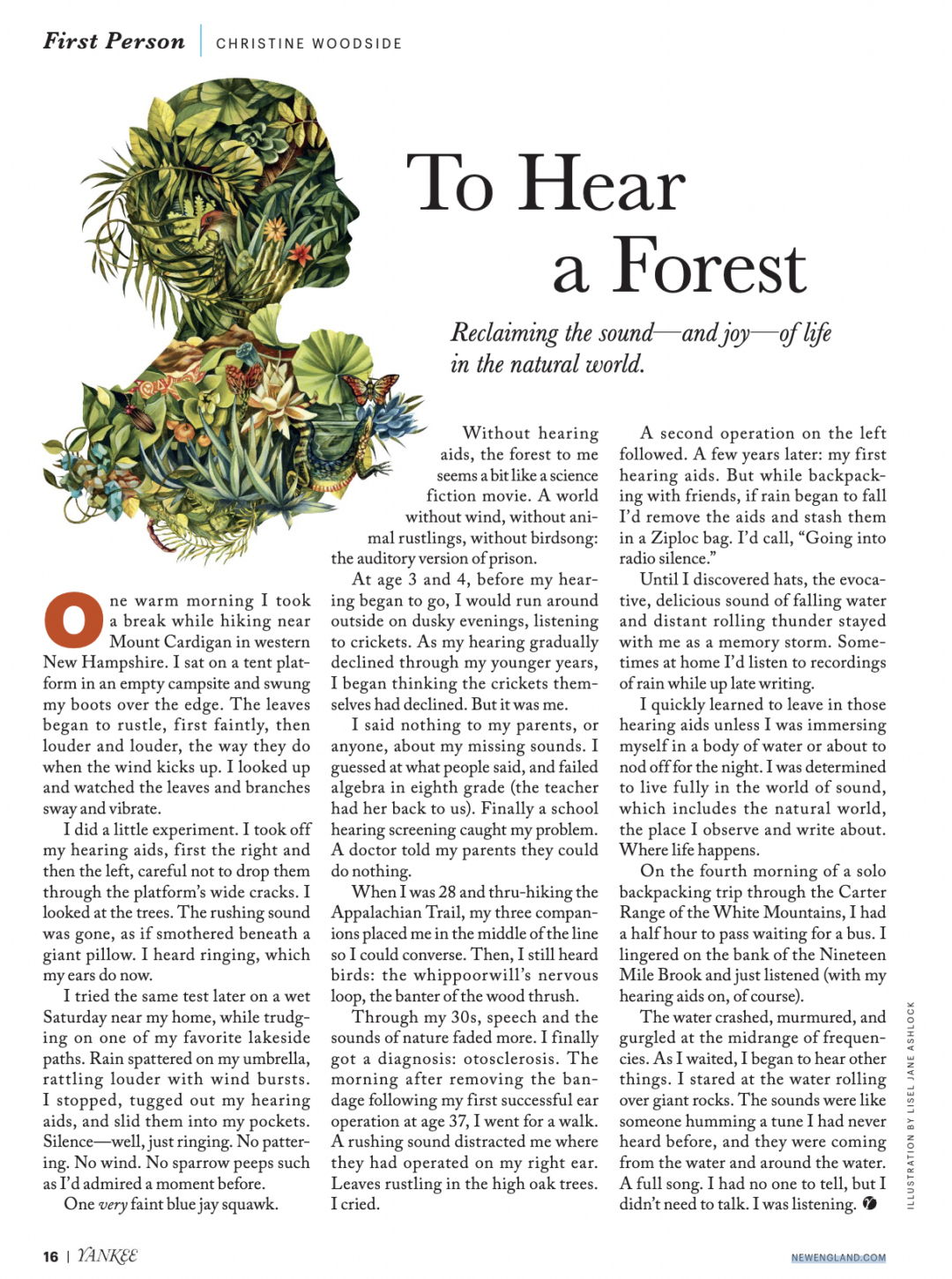One warm morning I took a break while hiking near Cardigan Mountain. I sat on a tent platform in an empty campsite and swung my boots over the platform edge. The leaves began to rustle, first faintly, then louder and louder, the way they do when the wind kicks up. I looked up and watched the leaves and branches sway and vibrate.
I did a little experiment. I pulled out my hearing aids, first the right and then the left, careful not to drop them through the platform’s wide cracks. I looked at the trees. The rushing sound was gone, as if smothered beneath a giant pillow. I heard ringing, which my ears do now.
I tried the same test on a wet Saturday near home, while trudging on one of my favorite lakeside paths. Rain spattered on my umbrella, rattling louder with wind bursts. I stopped, tugged out my hearing aids, and slid them in my pockets. Silence—well, ringing. No patters. No wind. No sparrow peeps such as I’d admired a moment before.
One very faint bluejay squawk.
Without hearing aids, the forest to me seems a bit like a science fiction movie: a world without wind, without animal rustlings, without birdsong: the auditory version of prison.
At age three and four, before my hearing began to go, I would run around outside on dusky evenings, listening to crickets. As my hearing gradually declined through my young years, I began thinking crickets had declined before they started declining. It was me.
I said nothing to my parents, or anyone, about my missing sounds. I guessed what people said, failed algebra in eighth grade (the teacher had her back to us), and then a school hearing screening caught my problem. A doctor told my parents they could do nothing. When I was 28, thru-hiking the Appalachian Trail, my three companions placed me in the middle of the line so that I could converse. I then still heard birds: the whippoorwill’s nervous loop, the banter of the wood thrush.
Through my 30s, speech and nature’s sounds faded more. I got a diagnosis: otosclerosis. The morning after removing the bandage following my first successful ear operation at age 37, I went for a walk. A rushing sound distracted me where they had operated on my right ear. Leaves rustling in the high oak trees. I cried.
A second operation on the left followed. A few years later, my first hearing aids. But while backpacking with friends, if rain began to fall, I’d pull out the aids and stash them in a Ziploc bag. I’d call, “Going into radio silence.”
Until I discovered hats, the evocative, delicious sound of falling water and distant rolling thunder stayed with me as a memory storm. Sometimes at home I’d listen to recordings of rain while up late writing.
I quickly learned to leave in those hearing aids unless I am immersing myself in a body of water or about to nod off for the night. I determined to live fully in the world of sound, which includes the natural world, the place I observe and write about. Where life happens.
On the fourth morning of a solo backpacking trip through the Carter range of the White Mountains, I had a half hour to pass waiting for a bus. I lingered on the bank of the Nineteen Mile Brook and just listened (with my hearing aids on, of course).
The water crashed, murmured, and gurgled at the midrange of frequencies. As I waited, I began to hear other things. I stared at the water rolling over giant rocks. The sounds were like someone humming a tune I had never heard before, and they were coming from the water and around the water. A full song. I had no one to tell, but I didn’t need to talk. I was listening.
This essay appears in Yankee magazine, May/June 2024, page 16.
